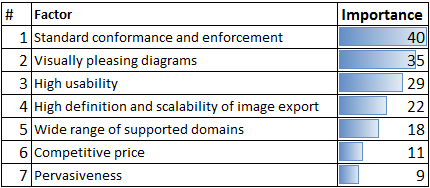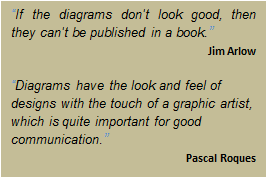
Interview and Survey of the Most Reputable Book Authors.
 MagicDraw is a business process, architecture, software and systems modeling tool. It is one of the most popular UML and SysML tools in the market. It has been available since 1998 and has over 500,000 installations in 10,000 companies in 90 countries.
MagicDraw is a business process, architecture, software and systems modeling tool. It is one of the most popular UML and SysML tools in the market. It has been available since 1998 and has over 500,000 installations in 10,000 companies in 90 countries.
More and more books, papers and even OMG specifications are prepared using MagicDraw, its plugins and other No Magic Inc. modeling products. Standard bodies such as ISO, OMG, ACORD, SWIFT, and others have adopted MagicDraw as the de facto standard for producing their work products. The most popular modeling books such as UML Bible by Tom Pender, and A Practical Guide to SysML: The Systems Modeling Language by Sanford Friedenthal are prepared using MagicDraw. The list of authors using MagicDraw includes: Jim Arlow, Tom Pender, Pascal Roques, Tim Weilkiens, and others.
We work closely with people to understand their needs, including authors. We interviewed some of the most reputable book authors to identify why and how they use modeling tools.
 They ranked the factors that modeling tools should satisfy from most important to least important and commented their choices. The first most important factor received 10 points, the second received 9 and so on. We combined factor scores and feedback from surveys. A summary of the factor scores is shown in Table 1.
They ranked the factors that modeling tools should satisfy from most important to least important and commented their choices. The first most important factor received 10 points, the second received 9 and so on. We combined factor scores and feedback from surveys. A summary of the factor scores is shown in Table 1.
The Truth is in the Details. So let’s see what reputable authors tell us why MagicDraw is beneficial for their work and why they recommend the product for their readers.
Why this group of users is important?
In addition to writing books, most of the authors do hundreds of consulting and training sessions, and contribute to standards. These are advanced, well-informed, and highly demanding users. They seek perfection in many areas. But most important is that the things important to them are valuable for everyone, and they had time to search, find and change for the best.
Key Factors in Details
1. Standard Conformance and Enforcement
MagicDraw supports the latest UML (one of the first to implement UML 2.0), SysML (first to implement V1.0, 1.1, and latest 1.2), BPMN, UPDM metamodels, XMI and EMF XMI standards for data storage and interchange. Incorrect model simply cannot be created.
Standards compliance is the single the most important factor authors find when preparing diagrams for a wide audience. Unlike most of the solutions in the industry d oes not use any tool-specific notations. Instead, MagicDraw enforces diagram and model correctness according to the standards only. Authors can be sure that their models are correct and fully standards complain so authors do not waste time correcting improper models.
oes not use any tool-specific notations. Instead, MagicDraw enforces diagram and model correctness according to the standards only. Authors can be sure that their models are correct and fully standards complain so authors do not waste time correcting improper models.
How this is achieved?
No Magic is a top influential member in the Object Management Group (OMG) organization. Our experts are significantly involved in OMG standards development. We are typically standards compliant even before the standards are released to the public. This is enabled by MagicDraw, a very versatile platform that is easily adaptable to changes in the standards.
2. Visually Pleasing Diagrams
Visually pleasing diagrams with 3D SHADOW, GRADIENT COLOR, and ROUNDED CORNERS OF PATHS for better-looking model presentations is the second most important requirement for authors. Additionally, an arc style line jump, for diagrams that have many intersecting links, makes them easier to understand.
On the other hand black and white notation is a must for scientific papers. According to Tim Weilkiens, it is important to have diagrams without any proprietary adornments with independent styles, e.g. no color shading etc.
3. High Usability
 MagicDraw provides intuitive controls within a very well designed GUI, that allows users to model without having to spend time learning about the controls. Authors admire how quickly they can learn the MagicDraw GUI and they value the ability to save time and improve productivity.
MagicDraw provides intuitive controls within a very well designed GUI, that allows users to model without having to spend time learning about the controls. Authors admire how quickly they can learn the MagicDraw GUI and they value the ability to save time and improve productivity.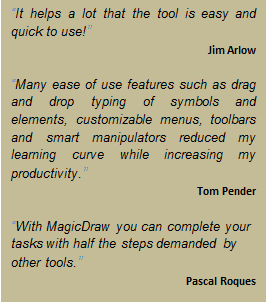
This is identified as the third most important factor. Tim Weilkiens strongly emphasized the usability of a tool. According to him, today poor usability is one of the main hurdles of introducing a modeling culture in a company.
Easy access to the most common operations is a cornerstone of MagicDraw’s user interface.
With hundreds of usability features such as:
- Element specific smart manipulators giving just the required relations set for the context.
- Drag and drop to set any property. Sample with Dependency Matrix
You’ll find MagicDraw indispensable for helping to reach high-velocity in diagram creation and editing, as all major commands are available through a single click.
How is this achieved?
- We just listen!
- Each new release contains enhancements and fixes requested by our users and our internal team.
- MagicDraw is mature – 10 years in the market means a lot.
4. High Definition and Scalability of Image Export
For publishing it is very important to produce high quality scalable graphics.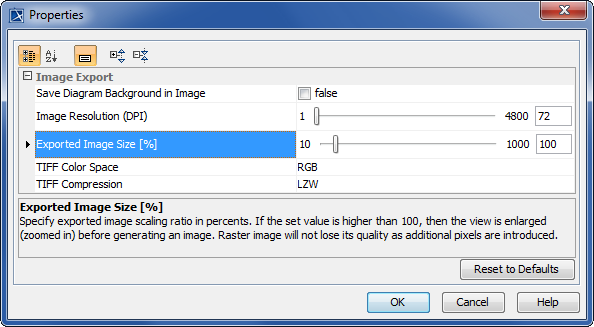
- Export to TIFF format. Widely supported by image-manipulation and publishing software, TIFF files can be edited and resaved without suffering a compression loss.
- Flexible image size. Higher resolution images can be produced without losing the quality, suitable for publishing.
- Custom DPI. Definable exported picture quality (resolution) gives raster images processing applications information to scale the image to appropriate size while being printed or displayed.
- Scalable SVG and EMF images export allows adjusting the size of already exported images without losing quality.
5. Wide Range of Supported Domains
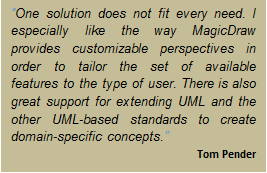 It is very important for the tool to support a variety of extensions that customize the product for a wide range of activities, that are described by the authors. Two examples of these are:
It is very important for the tool to support a variety of extensions that customize the product for a wide range of activities, that are described by the authors. Two examples of these are:- State machine and activity simulation supported by our first-in-the-industry extendable model execution framework based on OMG fUML and W3C SCXML standards
- MDA and custom modeling domain support, enabled by the flexible model driven MagicDraw Domain Specific Language (DSL).
Unlike in the open source market, our product compatibility is outstanding, with technology, language and domain extensions.
6. Competitive Price
The price is not always a major concern for the book authors. We leverage between expensive, often stagnant, non-flexible, old fashioned solutions and inexpensive, well known but in many aspects, fragile products. We maintain a reputation for the product with the best price for value.
Further Steps
We are happy to provide products so widely and so well recognized. From the interview and survey we also received a list of very valuable requested improvements. This will help us to continue to deliver the highest standard of solutions in the future.
About Authors
Pascal Roques
 The most famous French UML books (50,000 copies sold), and first SysML book author in France. Longtime trainer and consultant. System engineer and modeling expert.
The most famous French UML books (50,000 copies sold), and first SysML book author in France. Longtime trainer and consultant. System engineer and modeling expert.
Jim Arlow
 Independent author, trainer, consultant and researcher. His book – “UML 2 and the Unified Process” is one of the most popular and used as a standard textbook in hundreds of Universities worldwide.
Independent author, trainer, consultant and researcher. His book – “UML 2 and the Unified Process” is one of the most popular and used as a standard textbook in hundreds of Universities worldwide.
Tom Pender
 Author of one of the most popular UML books. Also Tom is author of several courses on UML, SysML, and UPDM. He has taught throughout the United States and in 12 other countries and has over 20 years of systems development experience in various industries.
Author of one of the most popular UML books. Also Tom is author of several courses on UML, SysML, and UPDM. He has taught throughout the United States and in 12 other countries and has over 20 years of systems development experience in various industries.
Tim Weilkiens
CEO of the German consulting company oose GmbH, is a member of OMG working groups about SysML and UML and has written sections of the SysML specification. He is involved in the INCOSE MBSE activities and co-founder of the MBSE Challenge Team SE^2 Telescope Modeling. Model based system engineering blog and one of the most popular SysML books author: www.model-based-systems-engineering.com.
